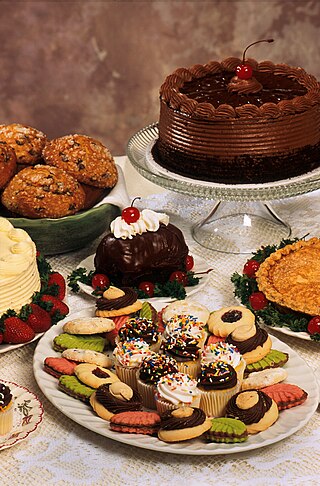
Dessert is a course that concludes a meal. The course consists of sweet foods, such as cake, biscuit, ice cream and possibly a beverage such as dessert wine and liqueur. Some cultures sweeten foods that are more commonly savory to create desserts. In some parts of the world there is no tradition of a dessert course to conclude a meal.
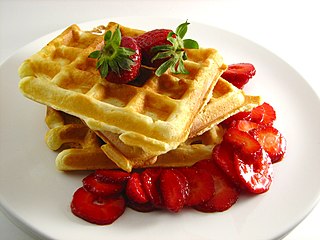
A waffle is a dish made from leavened batter or dough that is cooked between two plates that are patterned to give a characteristic size, shape, and surface impression. There are many variations based on the type of waffle iron and recipe used. Waffles are eaten throughout the world, particularly in Belgium, which has over a dozen regional varieties. Waffles may be made fresh or simply heated after having been commercially cooked and frozen.
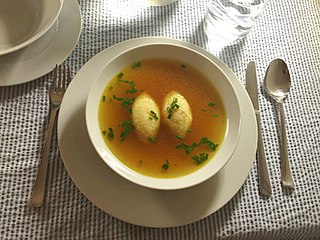
Austrian cuisine consists of many different local or regional cuisines. In addition to Viennese cuisine, which is predominantly based on the cooking traditions of the Habsburg Empire, there are independent regional traditions in all the states of Austria.
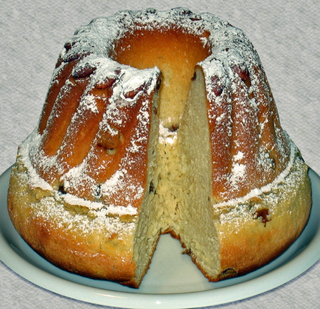
A Gugelhupf (also Kugelhupf, Guglhupf, Gugelhopf, pronounced[ˈɡuːɡl̩.hʊp͡f,-hɔp͡f,ˈkuːɡl̩-], and, in France, kouglof, kougelhof, or kougelhopf, is a cake traditionally baked in a distinctive ring pan, similar to Bundt cake, but leavened with baker's yeast.

A profiterole, chou à la crème, also known alternatively as a cream puff (US), is a filled French choux pastry ball with a typically sweet and moist filling of whipped cream, custard, pastry cream, or ice cream. The puffs may be embellished or left plain or garnished with chocolate sauce, caramel, or a dusting of powdered sugar.

A génoise, also known as Genoese cake or Genovese cake, is a French sponge cake named after the city of Genoa and associated with French cuisine. It was created by François Massialot in the late 17th century. Instead of using chemical leavening, air is suspended in the batter during mixing to provide volume.

Paska is a Ukrainian Easter bread. It is particularly spread in Central and Eastern European countries with cultural connections to the ancient Byzantine Empire, Eastern Orthodoxy or Eastern Catholicism. Easter breads are a traditional element in the Easter holiday cuisines of Armenia, Belarus, Bulgaria, Croatia, Georgia, Moldova, Romania, Russia, Poland, Slovakia and Ukraine. It is also eaten in countries with large immigrant populations from Central and Eastern Europe such as the United States, Canada and the United Kingdom. Easter bread is also a common tradition amongst the Assyrian-Chaldean-Syriac diaspora.

A Konditorei is a business that typically offers a wide variety of pastries and typically also serves as a café. Konditoreien (plural) are found in many countries including but not limited to Germany, Austria, Switzerland, France, Denmark, Sweden, and the Czech Republic. In French-speaking countries, similar businesses are referred to as pâtisseries.

Viennoiseries are French baked goods made from a yeast-leavened dough in a manner similar to bread, or from puff pastry, but with added ingredients, which give them a richer, sweeter character that approaches that of pastry. The dough is often laminated.

The poppy seed roll is a pastry consisting of a roll of sweet yeast bread with a dense, rich, bittersweet filling of poppy seed. An alternative filling is a paste of minced walnuts, or minced chestnuts.
Le Meilleur Pâtissier is a French culinary reality show broadcast on M6 since 2012 and in Belgium on RTL-TVI1.
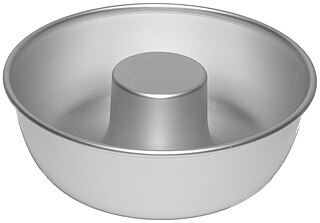
The savarin mould is a large ring shaped mould, designed originally with an accompanying gâteau recipe in mind. It was created by the Julien brothers, Parisian pastry chefs who owned Julien Frères, a respected pastry shop in Paris in the mid 19th century. The name Savarin is given in honour of Jean Anthelme Brillat-Savarin, the famous French gourmet, who gave Auguste Julien the recipe for the rum syrup used in the original Savarin Gâteau. In modern times, however, the moulds are used for many preparations, sweet and savoury, including meat, seafood, and vegetable dishes, as well as cakes, breads, mousses and jellies.

Gâteau nantais is a cake originating in the city of Nantes in France. It is a soft, round pound cake, made of flour, sugar, salted butter, eggs, and almond meal, then dampened with a punch of rum and lemon, sometimes with an apricot gelée centre. The round shaped cake top is topped with a white glaze thinned with rum, although lemon or orange blossom water can be substituted if the cake is to be served to children. It is recommended to make the cake a day before it is intended to be served. It keeps very well. An earlier version of the recipe, without eggs, reportedly kept for three to four weeks. In the modern recipe, the icing is white, whereas earlier versions were an amber colour.
Easter cakes (breads) are cakes prepared and served during the Easter season. Sharing a cake with family for Easter is an Easter tradition in many denominations and countries.
The fifth season of The Great Canadian Baking Show premiered on CBC Television on October 17, 2021. As with previous seasons, ten amateur bakers will compete over eight weeks of challenges, vying for the title. Ann Pornel and Alan Shane Lewis return for their second season as hosts. Bruno Feldeisen and Kyla Kennaley return for their fifth and third seasons respectively as judges.














